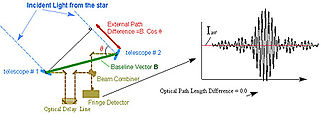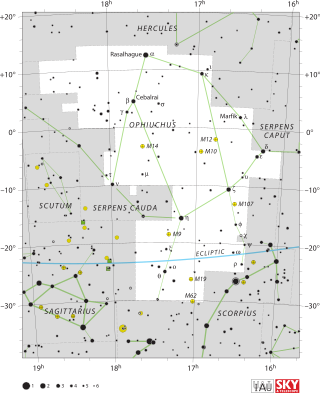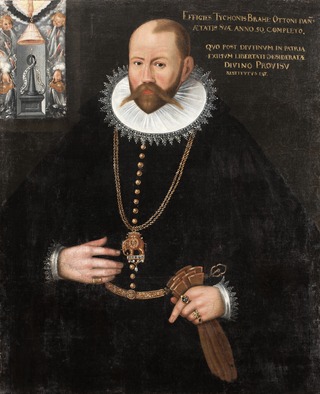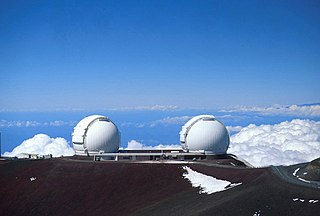
Astrometry is a branch of astronomy that involves precise measurements of the positions and movements of stars and other celestial bodies. It provides the kinematics and physical origin of the Solar System and this galaxy, the Milky Way.

Astronomy is the oldest of the natural sciences, dating back to antiquity, with its origins in the religious, mythological, cosmological, calendrical, and astrological beliefs and practices of prehistory: vestiges of these are still found in astrology, a discipline long interwoven with public and governmental astronomy. It was not completely separated in Europe during the Copernican Revolution starting in 1543. In some cultures, astronomical data was used for astrological prognostication.

Johannes Kepler was a German astronomer, mathematician, astrologer, natural philosopher and writer on music. He is a key figure in the 17th-century Scientific Revolution, best known for his laws of planetary motion, and his books Astronomia nova, Harmonice Mundi, and Epitome Astronomiae Copernicanae, influencing among others Isaac Newton, providing one of the foundations for his theory of universal gravitation. The variety and impact of his work made Kepler one of the founders and fathers of modern astronomy, the scientific method, natural and modern science. He has been described as the "father of science fiction" for his novel Somnium.

Ophiuchus is a large constellation straddling the celestial equator. Its name comes from the Ancient Greek ὀφιοῦχος (ophioûkhos), meaning "serpent-bearer", and it is commonly represented as a man grasping a snake. The serpent is represented by the constellation Serpens. Ophiuchus was one of the 48 constellations listed by the 2nd-century astronomer Ptolemy, and it remains one of the 88 modern constellations. An old alternative name for the constellation was Serpentarius.

Tycho Brahe, generally called Tycho for short, was a Danish astronomer of the Renaissance, known for his comprehensive and unprecedentedly accurate astronomical observations. He was known during his lifetime as an astronomer, astrologer, and alchemist. He was the last major astronomer before the invention of the telescope.

SN 1604, also known as Kepler's Supernova, Kepler's Nova or Kepler's Star, was a Type Ia supernova that occurred in the Milky Way, in the constellation Ophiuchus. Appearing in 1604, it is the most recent supernova in the Milky Way galaxy to have been unquestionably observed by the naked eye, occurring no farther than 6 kiloparsecs from Earth. Before the adoption of the current naming system for supernovae, it was named for Johannes Kepler, the German astronomer who described it in De Stella Nova.

A supernova remnant (SNR) is the structure resulting from the explosion of a star in a supernova. The supernova remnant is bounded by an expanding shock wave, and consists of ejected material expanding from the explosion, and the interstellar material it sweeps up and shocks along the way.
Timeline of stellar astronomy
Timeline of neutron stars, pulsars, supernovae, and white dwarfs

Simon Marius was a German astronomer. He was born in Gunzenhausen, near Nuremberg, but spent most of his life in the city of Ansbach. He is best known for being among the first observers of the four largest moons of Jupiter, and his publication of his discovery led to charges of plagiarism.
In ancient times, only the Sun and Moon, a few stars, and the most easily visible planets had names. Over the last few hundred years, the number of identified astronomical objects has risen from hundreds to over a billion, and more are discovered every year. Astronomers need to be able to assign systematic designations to unambiguously identify all of these objects, and at the same time give names to the most interesting objects, and where relevant, features of those objects.

SN 1054 is a supernova that was first observed on c. 10 July [O.S. c. 4 July] 1054, and remained visible until c. 12 April [O.S. c. 6 April] 1056.α

SN 1572, or B Cassiopeiae, was a supernova of Type Ia in the constellation Cassiopeia, one of eight supernovae visible to the naked eye in historical records. It appeared in early November 1572 and was independently discovered by many individuals.
Over the past few centuries, a small number of stars have been named after individual people. It is common in astronomy for objects to be given names, in accordance with accepted astronomical naming conventions. Most stars have not been given proper names, relying instead on alphanumeric designations in star catalogues. However, a few hundred had either long-standing traditional names or historic names from frequent usage.

Michael Maestlin was a German astronomer and mathematician, known for being the mentor of Johannes Kepler. He was a student of Philipp Apian and was known as the teacher who most influenced Kepler. Maestlin was considered to be one of the most significant astronomers between the time of Copernicus and Kepler.

The following outline is provided as an overview of and topical guide to astronomy:

The known history of supernova observation goes back to 1006 AD. All earlier proposals for supernova observations are speculations with many alternatives.

Paul Wittich was a German mathematician and astronomer whose Capellan geoheliocentric model, in which the inner planets Mercury and Venus orbit the Sun but the outer planets Mars, Jupiter and Saturn orbit the Earth, may have directly inspired Tycho Brahe's more radically heliocentric geoheliocentric model in which all the 5 known primary planets orbited the Sun, which in turn orbited the stationary Earth.
Laurentius Suslyga or Laurence Suslyga (1570–1640), was a Polish Jesuit historian, chronologist, and an author of Baroque visual poetry. He was the first person to claim that Jesus Christ was born in or before 4 BC, not in AD 1 or in 1 BC, as the Christian era would imply. Suslyga was thus questioning the Anno Domini chronology introduced by Dionysius Exiguus in AD 525. Suslyga presented this theory in his 1605 doctoral thesis entitled Theoremata de anno ortus et mortis Domini, deque universa Jesu Christi in carne oeconomia at the University of Graz. Among other arguments, Suslyga's treatise included the following: Herod's son, Philip the Tetrarch, renamed a city (Bethsaida) after Augustus's biological daughter, Julia. Since she had been exiled from Rome by Augustus in 2 BC, Suslyga assumed that Philip must have renamed the city prior to that date, and Herod must have died prior to Philip's becoming a ruler, which pushes the Massacre of the Innocents at least 3, if not more, years before AD 1. Dionysius Exiguus' chronology did need to be questioned; his chronology did not even match the point of view of the early Christians. The Church Fathers generally believed that Jesus was born either in the 41st or 42nd year of the reign of Augustus, that is in 3 or 2 BC.

Johannes van Heeck,, was a Dutch physician, naturalist, alchemist and astrologer. Together with Prince Federico Cesi, Anastasio de Filiis and Francesco Stelluti, he was one of the four founding members of the Accademia dei Lincei, the first learned society dedicated to understanding of the natural world through scientific enquiry.













